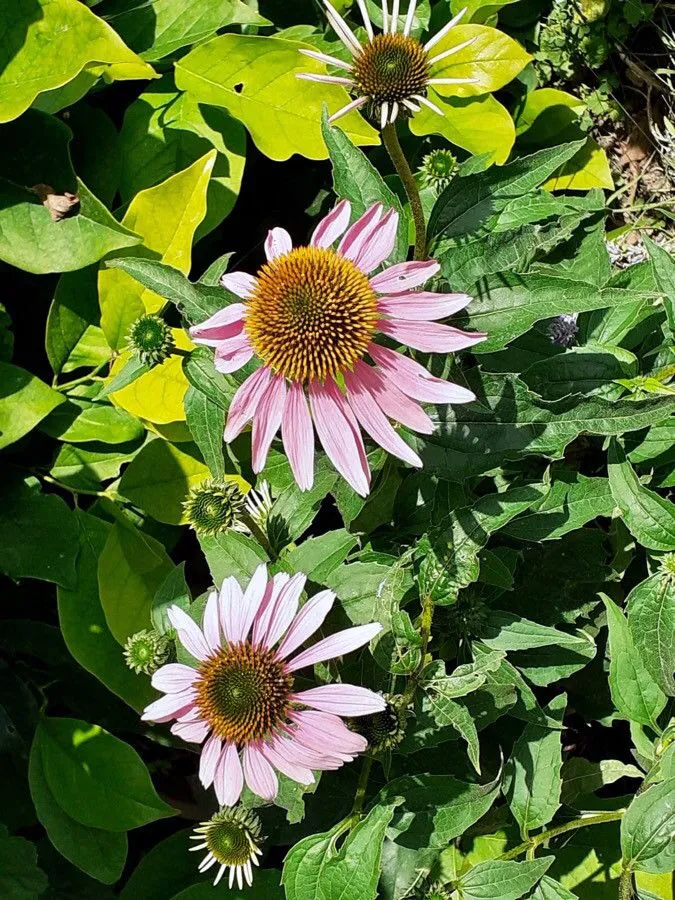
Author: (L.) Moench
Bibliography: Methodus: 591 (1794)
Year: 1794
Status: accepted
Rank: species
Genus: Echinacea
Vegetable: False
Observations: C. & E. U.S.A.
The Eastern purple-coneflower is a captivating and resilient perennial species that holds an esteemed position in the world of botany. Scientifically recognized as Echinacea purpurea, this plant belongs to the Asteraceae family, a diverse group encompassing many of nature’s most striking and beneficial flora.
Echinacea purpurea is native to the central and eastern regions of the United States, where it thrives in prairies, open woodlands, and along roadways. Its geographical prevalence within these regions lends credence to its adaptability and robust nature. The plant’s hardy disposition makes it a favorite among gardeners and horticulturists, who appreciate its ability to withstand various climatic conditions while adding a burst of color to their landscapes.
Characterized by its distinctive purple petals and prominent central cone, the Eastern purple-coneflower is not just a feast for the eyes but also plays a crucial role in local ecosystems. Its blossoms attract a myriad of pollinators, including bees, butterflies, and other beneficial insects, which facilitate cross-pollination and thereby support biodiversity.
Originally classified in 1794, as detailed in Moench’s Methodus (page 591), the plant has undergone numerous studies and discussions among botanists. This early documentation underscores its long-standing significance and the interest it has sparked over centuries. The suffix “L.” in its scientific name pays homage to Carl Linnaeus, the eminent Swedish botanist, reflecting Linnaeus’s primary classification, which Moench later expanded upon.
Beyond its aesthetic and environmental contributions, the Eastern purple-coneflower is also renowned for its medicinal properties. Native American tribes have long utilized parts of the plant for their therapeutic benefits, particularly in strengthening the immune system and combating infections. Modern science continues to explore these properties, resulting in Echinacea purpurea being a common ingredient in various dietary supplements and herbal remedies.
In conclusion, Echinacea purpurea, or the Eastern purple-coneflower, is a multifaceted plant that offers both ornamental and practical value. Its resilience and attractive appearance, combined with its ecological and medicinal benefits, secure its place as a beloved species within its native range and beyond. Whether growing wild across the plains of the central and eastern United States or cultivated in gardens worldwide, the Eastern purple-coneflower continues to be a plant of great interest and utility.
Por: cometa-roxo, equinácea, equinácea-púrpura, flor-roxa-cônica
Eng: eastern purple coneflower, eastern purple-coneflower, purple-coneflower, purple coneflower, broad-leaved purple coneflower, purple cone-flower
Dan: have-purpursolhat, purpursolhat
Deu: roter scheinsonnenhut, roter sonnenhut
Fra: echinacée pourpre, échinacée pourpre
Swe: röd rudbeckia, röd solhatt
Nno: purpursolhatt
Nob: purpursolhatt
En: Eastern purple-coneflower, Purple-coneflower, Eastern purple coneflower, PURPLE CONEFLOWER, Purple cone-flower, Broad-leaved purple coneflower
Ar: قنفذية أرجوانية
Be: Эхінацэя пурпуровая
Bg: Пурпурна ехинацея
Zh: 松果菊
Hr: Purpurna ehinacija
Cs: Třapatkovka nachová
Da: Have-Purpursolhat, Purpursolhat
Nl: Rode zonnehoed
Eo: Purpura eĥinaceo
Et: Punane siilkübar
Fo: Hava-purpursólhattur
Fi: Kaunopunahattu
Fr: Echinacée pourpre, Échinacée pourpre, Échinacée, Rudbeckia pourpre, Rudbeckie pourpre
De: Roter Scheinsonnenhut, Purpur-Sonnenhut, Roter Sonnenhut
El: Εχινάκεια η στενόφυλλη
Hu: Bíbor kasvirág
Kk: Күңгірт қызылкүрең
Lt: Rausvažiedė ežiuolė
No: Rød solhatt
Nb: Purpursolhatt
Nn: Purpursolhatt
Fa: سرخار گل
Pl: Jeżówka purpurowa
Pt: Cometa-roxo, Equinácea, Equinácea-púrpura, Flor-roxa-cônica
Ru: Echinacija purpurovaja, Эхинацея пурпурная
Sr: Ехинацеа
Es: Ameriški slamnik
Sv: Röd rudbeckia, Röd solhatt
Zh-tw: 松果菊
Taken Aug 17, 2021 by Dieter Wagner (cc-by-sa)
Taken Nov 7, 2017 by Manon Marchand (cc-by-sa)
Taken Jul 23, 2018 by Dieter Wagner (cc-by-sa)
Taken Jul 23, 2018 by Dieter Wagner (cc-by-sa)
Taken Apr 11, 2021 by Daniel O’Loughlin (cc-by-sa)
Taken Jun 29, 2012 by Tela Botanica − Yoan MARTIN (cc-by-sa)
Taken Jul 7, 2021 by Joanna Lovell (cc-by-sa)
Taken Jul 23, 2017 by Tara Conler (cc-by-sa)
Taken Jul 26, 2021 by Dieter Albrecht (cc-by-sa)
Taken Jul 11, 2021 by Dieter Wagner (cc-by-sa)
Taken Nov 14, 2020 by Palo Rapos (cc-by-sa)
Taken Aug 5, 2022 by Jim Knopf (cc-by-sa)
Taken Aug 23, 2019 by Frasca Gabri (cc-by-sa)
Taken Sep 14, 2021 by Jacques Zuber (cc-by-sa)
Taken Jul 23, 2018 by Dieter Wagner (cc-by-sa)
Taken Oct 7, 2017 by Tara Conler (cc-by-sa)
Taken Dec 16, 2017 by Tara Conler (cc-by-sa)
Taken Dec 16, 2017 by Tara Conler (cc-by-sa)
Taken Oct 26, 2017 by Tara Conler (cc-by-sa)
Taken Oct 26, 2017 by Tara Conler (cc-by-sa)
Taken Jun 24, 2020 by Matthias Foellmer (cc-by-sa)
Taken Aug 8, 2022 by Marcos75 (cc-by-sa)
Taken Jul 14, 2022 by Laszlo Tosoki (cc-by-sa)
Taken Aug 23, 2019 by Frasca Gabri (cc-by-sa)
Taken Nov 9, 2017 by Tara Conler (cc-by-sa)
© copyright of the Board of Trustees of the Royal Botanic Gardens, Kew.
© copyright of the Board of Trustees of the Royal Botanic Gardens, Kew.
© copyright of the Board of Trustees of the Royal Botanic Gardens, Kew.
Taken Jul 14, 2020 by Annemarie Fiegener (cc-by-sa)
Taken Jun 23, 2022 by mohammad fazel dehkordi (cc-by-sa)
Taken Sep 11, 2021 by Modi Elnadi (cc-by-sa)
Taken Aug 14, 2022 by Elena Diaz (cc-by-sa)
Taken Sep 11, 2021 by Rico Mende (cc-by-sa)
Growth form>: Single Stem
Growth habit>: Forb/herb
Growth rate>: Moderate
Ph maximum: 7.2
Ph minimum: 6.5
Family: Myrtaceae Author: (F.Muell.) K.D.Hill & L.A.S.Johnson Bibliography: Telopea 6: 402 (1995) Year: 1995 Status:…
Family: Rubiaceae Author: Pierre ex A.Froehner Bibliography: Notizbl. Bot. Gart. Berlin-Dahlem 1: 237 (1897) Year:…
Family: Sapindaceae Author: Koidz. Bibliography: J. Coll. Sci. Imp. Univ. Tokyo 32(1): 38 (1911) Year:…
Family: Asteraceae Author: A.Gray Bibliography: Pacif. Railr. Rep.: 107 (1857) Year: 1857 Status: accepted Rank:…
Family: Fabaceae Author: Medik. Bibliography: Vorles. Churpfälz. Phys.-Ökon. Ges. 2: 398 (1787) Year: 1787 Status:…
Family: Aspleniaceae Author: (Cav.) Alston Bibliography: Bull. Misc. Inform. Kew 1932: 309 (1932) Year: 1932…